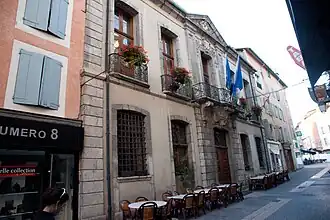Hôtel de Ville, Gap
| Hôtel de Ville | |
|---|---|
 The main frontage of the Hôtel de Ville in September 2011 | |
| General information | |
| Type | City hall |
| Architectural style | Neoclassical style |
| Location | Gap, France |
| Coordinates | 44°33′32″N 6°04′46″E / 44.5588°N 6.0794°E |
| Completed | 1743 |
| Design and construction | |
| Architect(s) | Sieur Lechat |
The Hôtel de Ville (French pronunciation: [otɛl də vil], City Hall) is a municipal building in Gap, Hautes-Alpes, in southeastern France, standing on Rue du Colonel Roux. It was designated a monument historique by the French government in 1948.[1]
History
The first town hall in Gap, the Maison Consulat (the consuls' house), was erected on the northwest side of what is now Rue du Colonel Roux, in around 1400. It consisted of an assembly hall, where the consuls met, and was extended by the addition of a clock tower in 1407. In late July 1692, the ruler of the Savoyard state, Victor Amadeus II, Duke of Savoy, operating as a member of the Grand Alliance, invaded the Dauphiné with a large army during the Nine Years' War.[2] Prince Eugene of Savoy was detached to take possession of Gap on 19 August 1692.[3] His troops attacked the town, drove the consuls out, and set fire to the town hall and other buildings.[4]
The consuls led the mayor, Jean Masseron, decided to restore the complex in 1700 and new bells, cast by Antoine and Claude Vallier, were installed in the newly restored clock tower June 1700.[5] In around 1740, after the old town hall became dilapidated, the consuls decided to demolish much of the old building, although retaining the clock tower, and to erect a new town hall alongside the clock tower. The new building was designed by Sieur Lechat in the neoclassical style, built in ashlar stone and was completed in 1743.[6][7]
The design involved a symmetrical main frontage of five bays facing onto the street. The central bay featured a segmental headed doorway with a moulded surround and ornate keystone on the ground floor, and a French door with a balcony and iron railings on the first floor. The French door was flanked by Doric order pilasters supporting a pediment with a coat of arms in the tympanum. The other bays were fenestrated by segmental headed windows on both floors. Internally, the principal room was the Salle du Conseil (council chamber).[8]
Following the liberation of the town by American troops and by the French Forces of the Interior on 20 August 1944, during the Second World War,[9][10] General Charles de Gaulle visited the town and laid a wreath at the war memorial in September 1948. On a return visit as President of France in October 1960, he visited the town hall and met with the mayor, Émile Didier, and other members of the council.[11]
References
- ^ Base Mérimée: PA00080569, Ministère français de la Culture. (in French)
- ^ Freiherr von Pufendorf, Samuel; de La Martinière, Antoine Augustin Bruzen; Sayer, Joseph (1764). An Introduction to the History of the Principal States of Europe. Vol. 2. A Wilde. p. 10.
- ^ Banks, John (1742). The History of Francis-Eugene Prince of Savoy By an English Officer, who Served Under His Highness in the Last War with France. James Hodges. p. 55.
- ^ Muston, Alexis (1866). The Israel of the Alps A Complete History of the Waldenses of Piedmont & Their Colonies. Blackie. p. 94.
- ^ "La tour de l'horloge de l'hôtel de ville de Gap: l'horloge et la cloche". Sylvie Damagnez. 5 May 2014. Retrieved 1 August 2025.
- ^ "Les richesses du patrimoine historique et naturel de Gap" (PDF). Terres de Gap. Retrieved 1 August 2025.
- ^ "La tour de l'horloge de l'hôtel de ville de Gap: l'Hôtel de Ville". Sylvie Damagnez. 5 May 2014. Retrieved 1 August 2025.
- ^ "Le programme du conseil municipal de vendredi soir". Le Dauphiné Libéré. 28 September 2023. Retrieved 1 August 2025.
- ^ "The resistance in the South of France the mainstay of the Liberation". Provence-Alpes-Côte d'Azur. Retrieved 1 August 2025.
- ^ "La libération de Gap, 20 août 1944". Musée de la résistance en ligne. Retrieved 1 August 2025.
- ^ "De Gaulle en libérateur puis en président de la République". Le Dauphiné Libéré. 8 November 2020. Retrieved 1 August 2025.